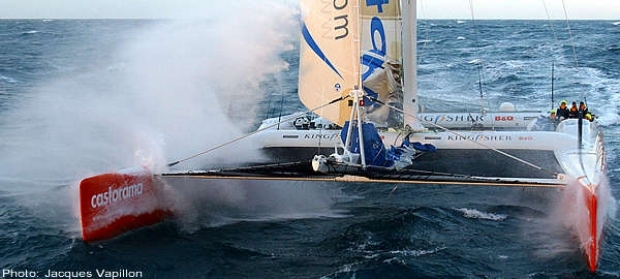Catamaran technique - part 6
Thursday November 27th 2003, Author: Andy Rice, Location: United Kingdom
Helena Darvelid is one of the most successful women sailors in the world. The Southampton-based Swede is best known for the 24-hour record that she and the crew of Tracy Edwards’ maxi-cat
Maiden
set in June 2002, when they covered a staggering 697 miles at an average speed of 29.04 knots. In fact she has been involved in 12 successful record attempts during her career, including cross-Channel and round-Britain records. Although she started out in big multihulls, she has enormous enthusiasm for small cat racing, and competed earlier this year in the Hobie Tiger Worlds in Singapore with boyfriend Paul Larsen, currently working towards breaking the 50-knot speed barrier with his SailRocket project. Here Helena gives Andy Rice an insight into how cutting edge developments could trickle down to small cat racing.
Being involved in the SailRocket programme, and also a British C-Class cat project for the Little America’s Cup, gives you some insight into how cat sailing might develop over the coming decade. The SailRocket craft has been designed to achieve speeds of 50 knots or more, while it is quite possible the C-Class cat will be capable of speeds up to 30 knots.
The problem with these extreme speeds is cavitation in the foils and the rig. The high technical aspect of these projects really focuses the mind on just how much foils make a difference, and I think we will see far greater refinement of boards and rudders on small cats as we gain a better understanding of how they work.
I haven’t been involved in the French 60ft tri circuit, but I suspect the curved foils and the canted rig technology could also be transferable to the small-cat scene (to read more about 60ft trimaran foils click here). I've recently been sailing in the Solent on an F-25 trimaran called Shiek Yerbouti. For a 25ft boat this is an impressively quick machine. You really feel the acceleration when you heat it up and get the apparent wind going. I'm sure we hit about 25 knots last weekend, for example. It's got a beautiful Marstrom wing-mast and Randy Smyth sails.
But what I found most interesting was the lack of a boom. The sail shape looked just fine without it, and I suppose it’s redundant, really, when you're sheeting to the centreline most of the time. Of course the Dart 18 has never had a boom, but the high-performance cats like the Tornado and F-18s still do. However, as cats get faster and rely increasingly on apparent wind sailing both upwind and downwind, booms could become a thing of the past.
If you think about how everything is being tested on the big ocean cats, with smaller diameter ropes and lighter rigging and sails, that technology should filter down eventually to the smaller cats too. A good example is PBO rigging which is becoming quite common on large offshore multis and monohulls. It can be as much as 30 per cent lighter than the wire equivalent, for no added windage, and this is a technology that could quite easily be applied to small cats once the costs come down a little more.
But one thing that won’t change is the high level of skill required to sail small cats. Guys like Gavin Colby are amazing at what they do, and everything happens so quickly in small cat sailing. I’ve done some rapid sailing on the big multis like Maiden - we hit 44 knots during our 24-hour record-breaking run - but I still find small cat racing among the most exhilarating sailing I’ve done. For someone who started out in big multis and worked her way down the size range, I’d say the small cat sailors are far better equipped to make the transition to big cat sailing than vice versa. The skills and responses you develop in an 18-foot cat are invaluable for sailing a 100+ft cat like Maiden or PlayStation.
On the big boat things happen a little slower and you can’t push the edges of performance quite as much, for obvious reasons. You're dealing with something where, if it went wrong, the end result could be very expensive, not to say fatal. It's all about safety and reliability. You can't take risks like that, although a background in small cat sailing will certainly equip you with the knowledge and understanding of where those safety limits lie when you go ocean cat sailing.









Latest Comments
Add a comment - Members log in